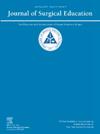访谈上限对眼科住院医师匹配的影响:一个旧金山匹配分析
IF 2.1
3区 医学
Q1 EDUCATION, SCIENTIFIC DISCIPLINES
引用次数: 0
摘要
目的评价访谈封顶对从旧金山(SF) match系统获取的2020 - 2021、2021 - 2022、2022 - 2023三个连续比赛周期眼科比赛结果数据的影响。设计对全国比赛数据进行回顾性横断面分析。设置2020 ~ 2021、2021 ~ 2022、2022 ~ 2023三个应用周期的旧金山Match系统。2594名眼科住院医师项目申请者中,剔除2020 - 2021年申请≤20个项目、2021 - 2022年申请≤18个项目、2022 - 2023年申请≤15个项目和退出匹配者后,纳入2266名。关于人口统计、申请量、面试邀请和匹配结果的去识别数据是从SF match系统收集的。根据面试邀请的数量(≤15 vs. > 15)对申请人进行分类。结果纳入分析的2266例中,匹配1519例(67.03%)。在所有应征者中,收到15次以上面试邀请的应征者( = 391)的匹配率为98.5%。相比之下,11到15个邀请的匹配率为93%,6到10个邀请的匹配率为61%,0到5个邀请的匹配率为62% (p = 0.043)。与接受>; 15面谈相关的因素包括:黑人(AOR: 9.39, 95% CI: 4.61-19.22)、西班牙裔(AOR: 2.69, 95% CI: 1.55-4.62)、拥有Alpha Omega Alpha荣誉(AOR: 3.34, 95% CI: 2.40-4.66)和更高的USMLE step2 CK分数(AOR: 1.12, 95% CI: 1.10-1.14)。男性申请者(AOR: 0.49, 95% CI: 0.36-0.67)和再申请者(AOR: 0.24, 95% CI: 0.07-0.64)获得15次面试的几率较低。面试上限可以通过防止竞争激烈的应聘者聚集在一起(通常被称为“面试囤积”)来促进面试邀请的更公平分配,而不会显著影响优秀候选人的匹配能力。需要进一步的研究来探讨为什么2%的面试超过15次的候选人不符合对定性因素进行调查的理由。本文章由计算机程序翻译,如有差异,请以英文原文为准。
Effect of Interview Cap on Ophthalmology Residency Match: A San Francisco Match Analysis
Objective
To assess the effect of interview capping on ophthalmology match results data from 3 consecutive match cycles (2020 to 2021, 2021 to 2022, and 2022 to 2023) obtained from the San Francisco (SF) Match system.
Design
Retrospective cross-sectional analysis of national match data.
Setting
San Francisco Match system during the 2020 to 2021, 2021 to 2022, and 2022 to 2023 application cycles.
Participants
Of 2594 applicants to ophthalmology residency programs, 2266 were included after excluding those who applied to ≤ 20 programs in 2020 to 2021, ≤ 18 in 2021 to 2022, ≤ 15 in 2022 to 2023, and those who withdrew from the match. De-identified data on demographics, application volume, interview invitations, and match outcomes were collected from the SF Match system. Applicants were categorized based on the number of interview invites (≤ 15 vs. > 15).
Results
Of the 2266 that were included in the analysis 1519 (67.03%) matched. Among all applicants, those who received more than 15 interview invites (n = 391) had a match rate of 98.5%. In comparison, match rates were 93% among those with 11 to 15 invites, 61% with 6 to 10, and 62% with 0 to 5 (p = 0.043). Factors associated with receiving > 15 interviews included identifying as Black (AOR: 9.39, 95% CI: 4.61-19.22), Hispanic (AOR: 2.69, 95% CI: 1.55-4.62), having Alpha Omega Alpha honors (AOR: 3.34, 95% CI: 2.40-4.66), and higher USMLE Step 2 CK scores (AOR: 1.12, 95% CI: 1.10-1.14 per unit increase). Male applicants (AOR: 0.49, 95% CI: 0.36-0.67), and reapplicants (AOR: 0.24, 95% CI: 0.07-0.64) had lower odds of receiving > 15 interviews.
Conclusions and Relevance
Interview caps may promote a more equitable distribution of interview invitations by preventing accumulation among a subset of highly competitive applicants, commonly referred to as “interview hoarding,” without significantly affecting top candidates’ ability to match. Further research is needed to explore reasons why 2% of candidates with greater than 15 interviews did not match warranting investigation into qualitative factors.
求助全文
通过发布文献求助,成功后即可免费获取论文全文。
去求助
来源期刊

Journal of Surgical Education
EDUCATION, SCIENTIFIC DISCIPLINES-SURGERY
CiteScore
5.60
自引率
10.30%
发文量
261
审稿时长
48 days
期刊介绍:
The Journal of Surgical Education (JSE) is dedicated to advancing the field of surgical education through original research. The journal publishes research articles in all surgical disciplines on topics relative to the education of surgical students, residents, and fellows, as well as practicing surgeons. Our readers look to JSE for timely, innovative research findings from the international surgical education community. As the official journal of the Association of Program Directors in Surgery (APDS), JSE publishes the proceedings of the annual APDS meeting held during Surgery Education Week.
 求助内容:
求助内容: 应助结果提醒方式:
应助结果提醒方式:


